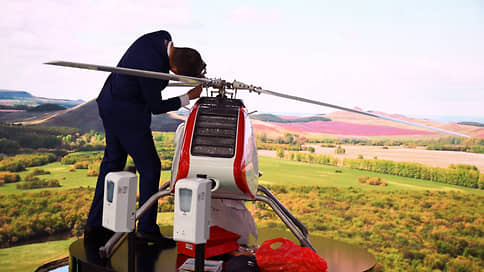The Ministry of Transport, amid drone attacks, is tightening the rules for flying drones and small aircraft
[ad_1]

As Kommersant found out, the Ministry of Transport, against the backdrop of drone attacks on industrial facilities, decided to tighten the rules for flying drones and small aircraft. From September 1, when flying in an area not controlled by air traffic controllers, deviation from the route by more than 10 km will be considered a violation. In addition, the restricted zone for drone flights near airports will be expanded to 30 km. This, according to experts, means difficulties for the operation of drones in almost all of Moscow. The Ministry of Transport also wants to ban drone flights over industrial facilities, which the industry considers impossible unless pilots are provided with the coordinates of restricted areas.
As Kommersant has learned, the Ministry of Transport has developed draft amendments to the Federal Rules for the Use of Airspace, which significantly restrict small aircraft flights in areas not controlled by air traffic controllers (class G airspace).
Changes to government decree No. 138, which Kommersant has reviewed, suggest that deviation from the route by more than 10 km is considered a violation, and they limit flights within a radius of 30 km from airports, over fuel and energy complex facilities, as well as transport and industrial infrastructure.
The new requirements are due to come into force on September 1. In the near future, according to Kommersant, the document will be sent to the government for approval. The Federal Air Transport Agency forwarded Kommersant’s questions to the Ministry of Transport, which did not comment on the situation.
The industry considers the requirements excessive. The letter to the Air Transport Operators Association notes: it is unclear what exactly is considered a deviation from the flight route in uncontrolled airspace, and who will control the location of aircraft and by what methods. They remind you: in class G space, obtaining air traffic control clearances is not required, as is the presence of two-way radio communication with the dispatcher, and the flight plan is provided on a notification basis. The association noted that such flights are not always route flights, but are carried out over certain areas: for example, during aerochemical and forestry work, aerial photography, etc.
In class G space, there is simply no one to “authorize” a change in flight route, points out expert in the field of air law and flight safety, member of the ICAO working group Andrey Shnyrev. He adds that, for example, balloons and gliders are not even theoretically capable of maintaining a given flight route. The expert notes that some types of aerial work require changing the flight route: work from moving sea vessels, ice reconnaissance, monitoring of wild animals, power lines and pipelines, security and other work. Threat of punishment in the form of a fine of up to 500 thousand rubles. and the risks of business interruption, he concludes, could force pilots and drone operators to “make life-threatening decisions.”
At the same time, the Ministry of Transport decided to tighten flight rules for drones, which were relaxed on March 1.
Thus, since March, there is no need to coordinate a drone flight plan near airports if it passes at an altitude of up to 100 m and at a distance of more than 10 km from airfield control points (2 km from landing sites). In the new version, the conditions are tightened: for flights at an altitude of up to 100 m, approvals will be required for flights within a radius of up to 10–30 km, for flights at an altitude of up to 150 m – up to 30 km. These restrictions are redundant if the drone operator can notify the airfield operator or the owner of the landing site about the flight, Mr. Shnyrev believes. According to him, the 30 km limit in the Moscow region will make it impossible for UAV flights within a radius of about 50 km from the Moscow Ring Road. The expert proposes to reduce the restricted zone to 10–15 km from airfield control points, but only “in the absence of agreement with the airfield operators and the owner of the landing site.” This makes it possible to ensure safety during UAV flights, since the entry point into the glide path of manned aircraft is located at an altitude of no lower than 400 m and no closer than 10 km, he explains. ICAO recommendations suggest a distance of up to 4 km, adds Andrey Patrakov, founder of the flight safety service RunAvia, while a reduction in this figure is also allowed.
In addition, the Ministry of Transport wants to tighten the rules for flying drones over infrastructure. From March 1, prohibited zones were introduced over the territories of transport facilities. From September 1, the Ministry of Transport proposes to ban flights over industrial facilities “marked by perimeter barriers.” Andrey Shnyrev considers this standard unenforceable, since an external pilot cannot notice “the fence of an electric transformer or a small rural gas station from the ground at a distance of 3 km.” Even with video equipment, this is not possible at high speed, he adds. In addition, it will be difficult for operators to accurately identify objects, since transport infrastructure may include parking lots, car service centers, garages and a number of road junctions.
To protect objects, experts consider it advisable to establish prohibited zones above them with reasonable height restrictions and to include data about such zones in aeronautical information. The task of independently searching and identifying such objects should not be assigned to drone operators, agrees Andrey Patrakov. In general, according to Mr. Patrakov, despite attempts at relaxation, the real liberalization of rules for drone operators is still going too slowly and lags behind international standards. Current regulation still weakly uses a risk-based approach, which is fully reflected in the ongoing total ban on drone flights in the regions, he believes.
[ad_2]
Source link





